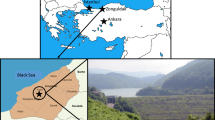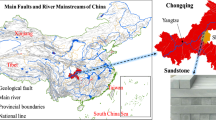Abstract
Naturally occurring gas hydrates are potential future energy source. A significant amount of gas hydrates is interpreted through seismic reflection data in the form of bottom simulating reflector (BSR) present in the sediments of the convergent continental margin of Pakistan. However, the seismic character of these hydratebearing unconsolidated sediments is not properly investigated. Since no direct measurements are available for quantitative estimation of gas hydrate and free gas in these sediments, therefore detailed knowledge of seismic velocities is essential. Seismic velocities of the gas hydrate-bearing sediments in the study area are estimated by using the effective medium theory and the fluid substitution modeling. The results show that the presence of gas hydrates increases the stiffness of the unconsolidated sediments; whereas the presence of free gas decreases the stiffness of these sediments. It is noted that seismic velocities and density of hydrate-bearing sediments are highly affected by saturation and distribution pattern of gas hydrates. The hydrate-bearing sediments seem to be characterized not only by high P-wave velocity (about 2800 m/s) but also by anomalously low S-wave velocity (about 850 m/s). As pure gas-hydrates have much higher seismic velocities than those of host sediments, presence of gas-hydrate increases the seismic velocities, whereas free-gas below the hydrate-bearing sediments decreases the velocities. Seismic reflection from the BSR exhibits a wide range of amplitude variation with offset characteristics, which depend upon the saturation and distribution of hydrates above and free gas below the BSR. We have also demonstrated that some attributes like acoustic and shear impedances, and AVO can be used as important proxies to detect gas hydrate saturation.
Similar content being viewed by others
References
Ahmed, N., Khalid, P., and Anwar, W.A., 2015a, Rock physics modeling to assess the impact of spatial distribution pattern of pore fluid and clay contents on acoustic signatures of partially-saturated reservoirs. Acta Geodaetica et Geophysica. doi:10.1007/s40328-015-0101-0
Ahmed, N., Khalid, P., Ghazi, S., and Anwar, W.A., 2015b, AVO forward modeling and attributes analysis for fluid’s identification: a case study. Acta Geodaetica et Geophysica. doi:10.1007/s40328-014-0097-x
Bangs, N.L.B., Sawyer, D.S., and Golovchenko, X., 1993, Free-gas at the base of the gas hydrate zone in the vicinity of the Chile triple junction. Geology, 21, 905–908.
Byrne, D.E., Sykes, L., and Davis, D.M., 1992, Great thrust earthquakes and a seismic slip along the plate boundary of Makran subduction zone. Journal of geophysical research, 97, 410–418
Castagna, J.P., Swan, H.S., and Foster, D.J., 1998, Framework for the interpretation of AVO intercept and gradient. Geophysics, 63, 948–956.
Chopra, S. and Marfurt, K.J., 2005, Seismic attributes–a historical perspective. Geophysics, 70, 3–28.
Dvorkin, J. and Nur, A., 1993, Rock physics for characterization of gas hydrate. In: Howell, D.G. (ed.), The future of energy gases. United States Geological Survey Professional Paper, 1570, 293–298.
Dvorkin, J. and Nur, A., 1996, Elasticity of high porosity sandstone: Theory for two North Sea datasets. Geophysics, 61, 1363–1370.
Ecker, C., Lumley, D., Dvorkin, J., and Nur, A., 1996, Structure of hydrate sediment from seismic and rock physics. 2nd Proceedings of the International Conference on Natural Gas Hydrates, Annals of the New York Academy of Sciences, June 19–22, p. 491–498.
Gassmann, F., 1951, Uber die Elastizit a tporoser Medien. Vierteljahrsschriftder aturforschenden Gesellschaft in Zurich, 96, 1–23.
Guerin, G., Goldberg, D., and Meltser, A., 1999, Characterization of in situ elastic properties of gas hydrate-bearing sediments on the, Blake Ridge. Journal of Geophysical Research, 104, 17781–17795.
Gosh, R. and Sain, K., 2008, Effective medium modeling to assess gas hydrate and free-gas evident from the velocity structure in the Makran accretionary prism, offshore Pakistan. Marine Geophysics, 29, 267–274.
Harms, J.C., Cappel, H.N., and Francis D.C., 1982, Geology and Petroleum Potential of the Makran Coast, Pakistan. 82nd Offshore South East Asia conference of Society of Petroleum Engineers, Singapore, Feb. 9–12, p. 3–26.
Helgerud, M.B., Dvorkin, J., and Nur, A., 1999, Elastic wave velocity in marine sediments with gas hydrates. Geophysical Research Letters, 26, 2021–2024.
Hill, R., 1952, The elastic behavior of a crystalline aggregate. Proceedings of the Physical Society of London, 65, 349–354.
Hill, R., 1963, Elastic properties of reinforced solids: Some theoretical principles. Journal of the Mechanics and Physics of Solids, 11, 357–372.
Hovland, M. and Judd, A.G., 1988, Seabed pock marks and seepages: Impact on geology, biology and the marine environment. Graham and Trotman Ltd., London, 135 p.
Hyndman, R.D. and Spence, G.D., 1992, A seismic study of methane hydrate marine bottom simulating reflectors. Journal of Geophysics Research, 97, 6683–6698.
Jakobsen, M., Hudson, J.A., Minshull, T.A., and Singh, S.C., 2000, Elastic properties of hydrate-bearing sediments using effective medium theory. Journal of Geophysics Research, 105, 561–577.
Kadri, I.B., 1995, Petroleum Geology of Pakistan. Pakistan Petroleum Ltd., Karachi, 234 p.
Khalid, P., Broseta, D., Nichita, D.V., and Blanco, J., 2014, A modified rock physics model for analysis of seismic signatures of low gas-saturated rocks. Arabian Journal Geosciences, 7, 3281–3295.
Koh, C.A. and Sloan E.D., 2007, Natural gas hydrates: Recent advances and challenges in energy and environmental applications. AIChe Journal, 53, 1636–1643.
Kvenvolden, K.A., 1993, Gas hydrates Geological perspective and global change. Review Geophysics, 31, 173–187.
Kvenvolden, K.A., 1998, A primer on the geological occurrence of gas hydrate. In: Henriet, J.P. and Mienert, J. (eds.), Gas hydrates: Relevance to the World Margin Stability and Climate Change. Geological Society, London, Special Publication, 137, 9–30.
Lee, M.W. and Collett, T.S., 2001, Comparison of elastic velocity models for gas hydrate-bearing sediments. In: Paull, C.K. and Dillon, W.P. (eds.), Natural gas hydrates: occurrence, distribution and detection. American Geophysical Union, Washington, D.C., Geophysical Monograph, 124, 179–188.
Lee, M.W. and Dillon, W.P., 2001, Amplitude blanking related to the pore filling of gas hydrate in sediments. Marine Geophysical Research, 22, 101–109.
Lee, M.W., 2004, Elastic velocities of partially gas-saturated unconsolidated sediments. Marine and Petroleum Geology, 21, 641–650.
Markl, R., Bryan, G., and Ewing, J., 1970, Structure of the Blake-Bahama outer Ridge. Journal of Geophysical Research, 75, 539–4555.
Mavko, G., Mukerji, T., and Dvorkin, J., 2009, The Rock Physics Handbook. Cambridge University Press, Cambridge, 324 p.
Miller, J.J., Lee, M.W., and Von-Huene, R., 1991, An analysis of a seismic reflection from the base of a gas hydrate zone, offshore Peru. Bulletin of American Association of Petroleum Geosciences, 75, 910–924.
Minshull, T.A. and White, R.S., 1989, Sediment compaction and fluid migration in the Makranaccretionary prism. Journal of Geophysics Research, 94, 7387–7402.
Minshull, T.A. and Singh, S.C., 1994, Seismic velocity structure at a gas hydrate reflector, offshore Columbia, from full wave form inversion. Journal of Geophysics Research, 99, 4715–4734.
Mokhtari, M., Abdollahie, F.I., and Hessami, K., 2008 Structural elements of the Makran Region, Oman Sea and their potential relevance to tsunami genesis. Natural Hazards, 47, 185–199.
Ojha, M. and Sain, K., 2008, Appraisal of gas hydrate/free-gas from VP/VS ratio in the Makran accretionary prism. Marine Petroleum Geology, 25, 637–644.
Paull, C.K., Ussler, W., and Dillon, W.P., 1991, Is the extent of glaciation limited by marine gas-hydrates? Geophysical Research Letters, 18, 432–434.
Platt, J.P., Loggett, J.K., Young, J., Roza, H.A., and Alam, S., 1985, Large scale sediment underplating in the Makran accretionary prism, south west Pakistan. Geology, 13, 215–218.
Powell C.Mc.A., 1979, A speculative tectonic history of Pakistan and surroundings: some constraints from the Indian Ocean. Geodynamics of Pakistan, 13, 5–24.
Quittmeyer, R.C. and Kafka, A.L., 1984, Constraints on plate motions in southern Pakistan and the northern Arabian Sea from the focal mechanisms of small earthquakes. Journal of Geophysics Research, 89, 2444–2458.
Reuss, A., 1929, Berechnung der fliessgrense von mischkristallen auf grund der plastizitatbedingung fur einkristalle. Zeitschrift fur Ange-wandte Mathematikaus Mechnik, 9, 49–58.
Sakai, A., 1999, Velocity analysis of vertical seismic profile (VSP) survey at JAPEX/JNOC/GSC MAllik 2L-38 Gas hydrate research well, Mackenzie Delta, Northwest Territories, Canada. In: Dallimore, S.R., Uchida, T., and Collett, T.S. (eds.), Bulletin-Geological Survey of Canada Vol. 544. Geological Survey of Canada, Ottawa, 323–340.
Sain, K., Minshull, T.A., Singh, S.C., and Hobbs R.W., 2000, Evidence for a thick free-gas layer beneath the bottom simulating reflector in the Makran accretionary prism. Marine Geology, 164, 37–51.
Satyavani, N., Thakur, N.K., Aravind, K.N., and Reddi, S.I., 2005, Migration of methane at the diapiric structure of the western continental margin of India–insights from seismic data. Marine Geology, 219, 19–25.
Schluter, H.U., Prexl, A., Gaedicke, C., Roeser, H., Reichert, C., Meyer, H., and Daniels, C., 2002, The Makran accretionary wedge: sediment thicknesses and ages and the origin of mud volcanoes. Marine Geology, 185, 219–232.
Sloan, E.D., 1998, Clathrate hydrate of natural gases. Marcel Dekker, New York, 231 p.
Taylor, M.H., Dillon, W.P., and Pecher, I.A., 2000, Trapping and migration of methane associated with the gas hydrate stability zone at the Blake ridge diapir: new insights from seismic data. Marine Geology, 164, 79–89.
Voigt, W., 1910, Lehrbuch der Kristallphysik. Leipzig, Teubner, 67 p.
Wood, A.B., 1941, A textbook of sound. Bell and Sons, London, 132 p.
White, J.E., 1975, Computed seismic speed and attenuation in rocks with partial gas saturation. Geophysics, 40, 224–232.
Wood, W.T., Stoffa, P.L., and Shipley, T.H., 1994, Quantitative detection of methane hydrate through high-resolution seismic velocity analysis. Journal of Geophysics Research, 99, 9681–9695.
Zoeppritz, K., 1919, Erdbebenwellen VIIIB, On the reflection and propagation of seismic waves. Gottinger Nachrichten, I, 66–84.
Author information
Authors and Affiliations
Corresponding author
Additional information
An erratum to this article is available at http://dx.doi.org/10.1007/s12303-016-0032-y.
Rights and permissions
About this article
Cite this article
Ehsan, M.I., Ahmed, N., Khalid, P. et al. An application of rock physics modeling to quantify the seismic response of gas hydrate-bearing sediments in Makran accretionary prism, offshore, Pakistan. Geosci J 20, 321–330 (2016). https://doi.org/10.1007/s12303-015-0044-z
Received:
Accepted:
Published:
Issue Date:
DOI: https://doi.org/10.1007/s12303-015-0044-z




